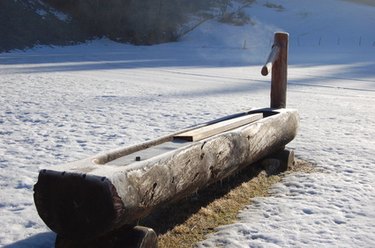Things You'll Need
Three 2-by-12-by-48-inch rough milled pine boards
Two 2-by-12-by-12-inch rough milled pine boards
Tape measure
Screw gun
Coated 3 ½-inch deck screws
Two 4-by-4-by-12-inch rough milled pine posts

Water troughs were traditionally constructed out of wood. More recently, troughs are made out of galvanized metal, stainless steel or some form of plastic. Although these modern troughs may have the advantage of durability, they lack character and time-honored tradition. A modern organic farmer or those interested in self-sufficient homesteading would do well to construct their own watering troughs out of wood. Although wood is not the most durable method for storing water, it does hold water well and can be replaced or repaired with ease and little expense.
Step 1
Set two of the 2-by-12-by-48-inch rough milled pine boards parallel to each other approximately 12 inches apart. Measure with a tape measure 3 inches in from each end of both boards. Mark these points with a pencil.
Video of the Day
Step 2
Place the two 2-by-12-by-12-inch rough milled pine boards between the two long boards so that they are perpendicular to them and lined up with the pencil marks.
Step 3
Fasten the boards together using a screw gun and 3 ½-inch coated deck screws. Screw from the outside of the long boards into the ends of the square boards. This forms the basic box for the trough.
Step 4
Take the remaining long pine board and lay it in line with the edges of the box. This will form the bottom of the trough. Use a screw gun to screw the bottom into place. Space the screws evenly every 6 to 8 inches.
Step 5
Flip the trough over. Place the two 4-by-4-by-12-inch rough milled pine posts parallel to each other approximately 36 inches apart. Set the trough on these posts. The posts form the base for the trough, which simply rests on them.
Step 6
Fill the trough with water. It may leak until the wood swells. Once the wood has swelled, the trough will cease to leak.
Tip
If leaking is a great concern, melt paraffin wax and pour it along the seams of the bottom of the trough.
Warning
Do not use treated wood. Treated or painted wood presents a health risk to animals. Always wear safety glasses when woodworking. Follow tool safety instructions.
Video of the Day